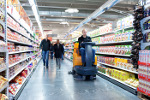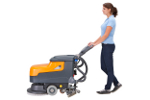Issue Date: 19 September 2012
Ref: DIV12/06
WHAT TO LOOK FOR IN A SCRUBBER DRIER
Do’s, Don’ts and Latest Developments
Scrubber driers allow daily floor cleaning and routine maintenance tasks to be carried out quickly and efficiently. But the choice of equipment can be bewildering and all machines are not the same. What are the key points when making a decision?
The first consideration is to match the machine to the application. Too big, and the machine will always be under-utilised and can never justify the investment. Too small, and it cannot cover the floor quickly enough which means it will be unproductive and uneconomical and perhaps suffer from overwork which can lead to unreliability. Leading manufacturers such as TASKI by Diversey, now part of Sealed Air, provide choice by offering machines ranging from the size of a domestic vacuum cleaner up to that of a small car.
Another consideration is power. Mains powered machines offer 24/7 availability which is ideal for intensive daily cleaning applications although they are restricted by the length of cable and position of local sockets. Battery powered machines offer complete autonomy and can free-range where the presence of a cable is undesirable or unsafe. This often makes them the preferred choice for retail, healthcare, transport and daytime cleaning applications. The batteries must provide enough power to clean the floor in the available time but over-specification can be uneconomical. Batteries must also, of course, be recharged but advances in technology mean they now offer more uptime and are much more energy-efficient than their predecessors. Leading manufacturers typically offer their most popular machines in a choice of mains or battery format.
Scrubber driers can also be used for tasks beyond daily cleaning such as stripping finishes and applying new product. Choosing the right pad or brush for the task and floor type is critical. Textured or tiled floors require equipment that can clean in recessed surfaces. In general, if the pad or brush is too abrasive it can damage the floor but if not aggressive enough it will not have the desired performance to remove soil or finish.
Some operators have experimented with cleaning with water alone to promote sustainability but this can be a false economy. Chosen correctly an appropriate product offers superior performance as well as long-term protection of the floor and enhanced appearance that is important to many occupants and their visitors. As with pads and brushes it is important to choose the right cleaning product for the particular machine and floor type. Manufacturers such as TASKI by Diversey with an integrated range of cleaning products and close relationships with specialist suppliers will advise on the best combination of machine, cleaning product and pads for any given application.
The design of the squeegee (including correct blade) and pickup mechanism is fundamental. The aim is to leave the floor clean and dry so it can be walked on almost immediately. The W-shaped squeegee used on many TASKI by Diversey machines, for example, has self-levelling castors to follow closely the profile of the floor. With its two direct-suction points this helps ensure 99 per cent of water or solution is removed with reduced risk of clogging the pick-up. A tricycle layout generally enables a machine to follow the contours of the floor better than four-wheel models.
Other innovations found on the latest models include improved ergonomic control layout and facilities to program a machine for specific applications and remember settings for future use. These and similar features promote ease-of-use and enhance productivity.
Operators concerned with sustainability look for energy efficiency and reduced water and cleaning product consumption. Various design enhancements, and advances in battery technology, mean that current models are much more energy efficient than previous generation machines. Innovations that match the amount of solution applied with machine speed reduce wastage and eliminate the risk of puddles. Systems that support on-demand dilution and insert product directly into delivery lines avoid the need to mix product in the machine’s water tank. This helps promote cleaning consistency and avoids the need to empty or rinse the tank after work which saves time and reduces wastage.
A final consideration affecting reliability, efficiency and overall cost of ownership is maintenance. Many larger machines cost as much as a small car yet operators ignore anything beyond the most basic service checks. With machines of all sizes a service contract or, at the very least, regular maintenance can prolong working life and protect investment. TASKI by Diversey has increased component commonality across its range which helps service engineers achieve much higher first-time-fix rates.
To support daily and routine checks the best machines incorporate service points that are easy to identify and access. This makes it easier to train operators who are then more likely to look after their equipment. It should also be possible to replace or exchange serviceable components and attachments such as pads without special tools to promote simple and prompt maintenance. TASKI by Diversey machines have yellow service points for this purpose. They also incorporate an indicator which shows when the machine has reached a specific number of hours and is due for a service.


